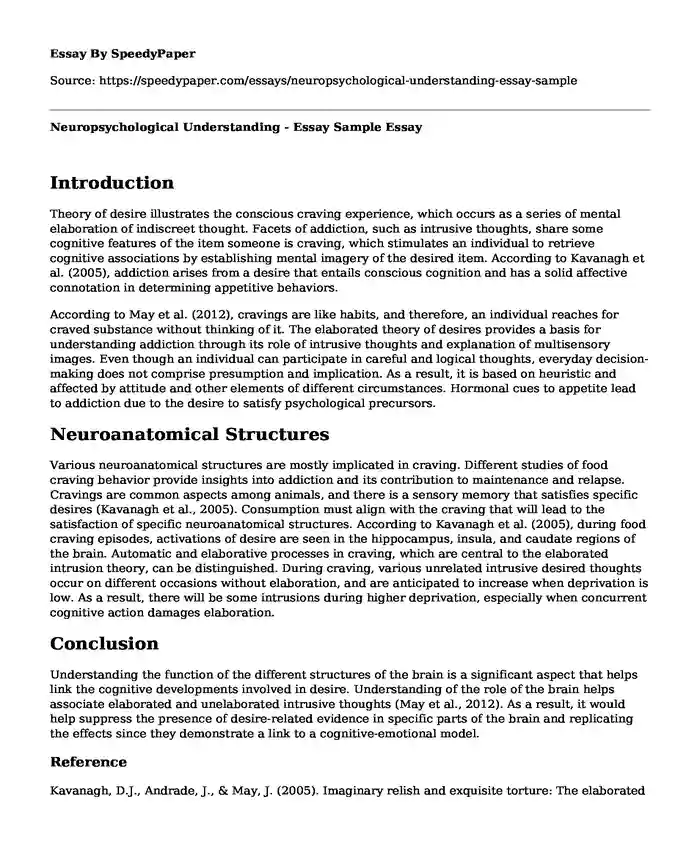
| Type of paper: | Essay |
| Categories: | Psychology Science |
| Pages: | 2 |
| Wordcount: | 447 words |
Introduction
Theory of desire illustrates the conscious craving experience, which occurs as a series of mental elaboration of indiscreet thought. Facets of addiction, such as intrusive thoughts, share some cognitive features of the item someone is craving, which stimulates an individual to retrieve cognitive associations by establishing mental imagery of the desired item. According to Kavanagh et al. (2005), addiction arises from a desire that entails conscious cognition and has a solid affective connotation in determining appetitive behaviors.
According to May et al. (2012), cravings are like habits, and therefore, an individual reaches for craved substance without thinking of it. The elaborated theory of desires provides a basis for understanding addiction through its role of intrusive thoughts and explanation of multisensory images. Even though an individual can participate in careful and logical thoughts, everyday decision-making does not comprise presumption and implication. As a result, it is based on heuristic and affected by attitude and other elements of different circumstances. Hormonal cues to appetite lead to addiction due to the desire to satisfy psychological precursors.
Neuroanatomical Structures
Various neuroanatomical structures are mostly implicated in craving. Different studies of food craving behavior provide insights into addiction and its contribution to maintenance and relapse. Cravings are common aspects among animals, and there is a sensory memory that satisfies specific desires (Kavanagh et al., 2005). Consumption must align with the craving that will lead to the satisfaction of specific neuroanatomical structures. According to Kavanagh et al. (2005), during food craving episodes, activations of desire are seen in the hippocampus, insula, and caudate regions of the brain. Automatic and elaborative processes in craving, which are central to the elaborated intrusion theory, can be distinguished. During craving, various unrelated intrusive desired thoughts occur on different occasions without elaboration, and are anticipated to increase when deprivation is low. As a result, there will be some intrusions during higher deprivation, especially when concurrent cognitive action damages elaboration.
Conclusion
Understanding the function of the different structures of the brain is a significant aspect that helps link the cognitive developments involved in desire. Understanding of the role of the brain helps associate elaborated and unelaborated intrusive thoughts (May et al., 2012). As a result, it would help suppress the presence of desire-related evidence in specific parts of the brain and replicating the effects since they demonstrate a link to a cognitive-emotional model.
Reference
Kavanagh, D.J., Andrade, J., & May, J. (2005). Imaginary relish and exquisite torture: The elaborated intrusion theory of desire. Psychological Review, 112(2), 446-467. Doi: 10.1037/0033-295X.112.2.446
May, J., Andrade, J., Kavanagh, D. J., & Hetherington, M. (2012). Elaborated intrusion theory: a cognitive-emotional theory of food craving. Current Obesity Reports, 1(2), 114-121.
https://doi.org/10.1007/s13679-012-0010-2.
Cite this page
Neuropsychological Understanding - Essay Sample. (2023, Dec 25). Retrieved from https://speedypaper.com/essays/neuropsychological-understanding-essay-sample
Request Removal
If you are the original author of this essay and no longer wish to have it published on the SpeedyPaper website, please click below to request its removal:
- Forgiveness Essay Example
- Free Essay for Everyone: Biological Evidence and Serology
- Free Essay Providing the Investigations of Violence, Property and Other Crimes
- Free Paper Example of Short Story: The Defeat
- Free Essay Example on Effects of Revenge on Human Connections
- The Birth of a New Physics: The 17th-Century Revolution - Essay Sample
- Essay Sample on Social Class and Political Power
Popular categories




